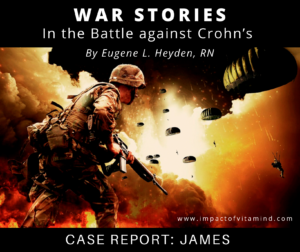War Stories: Kelly

Topic: Crohn’s; Cholinergic anti-inflammatory pathway
Last revision: 12-14-22
War Stories: Kelly
By Eugene L. Heyden, RN
“Recent evidence supports the idea that the central nervous system interacts dynamically via the vagus nerve with the intestinal immune system to modulate inflammation through humoral and neural pathways, using a mechanism also referred to as the intestinal cholinergic anti-inflammatory pathway.” ~Goverse et al, 2016, emphasis added
“In this sense, the regulation of inflammation seems to be considered in terms of checkpoints. Among these mechanisms, the nervous system is the main regulator of the immune system.” ~Peña et al., 2011, emphasis added
Surprisingly, the nervous system can exert control over the inflammatory responses occurring in the bowel. It can do this using the vagus nerve, along with cellular-surface receptors responsive to the chemical the vagus nerve releases to get things done. The chemical is called acetylcholine. The immune cells that are intimately involved in promoting inflammation “listen” to messages delivered from brain to immune cell, via the vagus nerve, and respond accordingly. If the stimulus is sufficiently strong, the immune cells are “instructed” to reduce their proinflammatory activity. This system allows neurological control of inflammation is called the Cholinergic Anti-inflammatory Pathway. It is a very powerful pathway and can be upregulated by electrically stimulating the vagus nerve. Let’s see this thing in action.
Case report: Kelly
Kelly was 29 years old at the time her story appeared in an article written by Emily Waltz, posted in 2018. She had been ill since age 13—first with inflammatory arthritis in one ankle, then over the course of a few years both ankles became involved as it worked its way up to include both arms. Pain was both severe and debilitating. Shortly after the onset of arthritic symptoms, here come the tummy troubles that soon lead to the diagnosis of Crohn’s disease. And if that wasn’t enough, skin ulcerations showed up from out of nowhere, to add to all the misery. Years of misery.
“I went very quickly from being an athletic kid to feeling like a 90-year-old woman,” she recounts. And, like the majority of 90-year-old women, Kelly developed osteoporosis, due to the chronic use of steroids, prescribed to control her disease. “By her mid 20s, she couldn’t walk a couple of blocks without stopping on a bench to rest. Each movement was painful. She had to quit her job as a high school English teacher.” (Waltz, 2018) Kelly’s life was so vastly different from anything she had in mind. Putting up with this crap (medical term, I think), for well over a decade, would be enough to take the fight out of the best of the best. But not Kelly. She was determined to find a way out.
Kelly just happened to run across an on-line interview with Dr. Kevin Tracey, showcasing a revolutionary treatment for inflammatory disorders, based on the discoveries made by him and his colleagues. Kelly was more than intrigued, she was convinced that this revolutionary treatment—electrical stimulating the vagus nerve—could help her in her battle against Crohn’s. She tracked down Dr. Tracey’s email address and told him her story. At the time (2014), Dr. Tracey did not have a lot to offer Kelly. So she continued with all the suffering and with all the failure of conventional therapy for another 3 years (Lama, 2019).
But enough is enough, and Kelly contacted Dr. Tracey once again, hoping for a better outcome. From this contact, Kelly learned there was a company based in California, SetPoint Medical, conducting a clinical trial in Europe using electrical vagal nerve stimulation to treat Crohn’s (Lama, 2019). This was all she needed to know. Shortly after contacting SetPoint Medical, Kelly was enrolled in the clinical trial.
For Kelly, soon it was off to Europe, wheelchair bound, with her husband at her side, to participate in the clinical trial in question. The rest is history.
“A surgeon implanted her device on June 22, 2017, she says. Stimulation started two weeks later. Two weeks after that ‘I was running from train to train to make my appointments,’ said Owens in the interview with Spectrum. ‘I remember one time my husband and I were late for an appointment at the Academic Medical Center, and I ran up two flights of stairs and got to the top and didn’t see my husband anywhere. I looked down to the bottom of the stairs and he’s standing there with his mouth open, shocked at what I had just done.’
“Now, a year since her surgery, Owens says she runs, does weight training, exercises on the elliptical, and has no more Crohn’s symptoms. ‘It’s just gone,’ she says. ‘I don’t have pain or swelling. I’m able to eat regular foods. A salad used to destroy my stomach and now I live on salad.’ She still has osteoporosis, but hopes that will improve too with calcium supplements.” (Waltz, 2018)
Read Kelly’s story yourself. You’ll be impressed. Her story is told at the following:
https://www.newsday.com/news/health/crohns-drugs-feinstein-institute-1.20780533
https://time.com/5709245/bioelectronic-medicine-treatments/
What just happened?
“The vagus nerve not only is essential in the detection of inflammation but also provides an important route through which the central nervous system can respond.” ~Van Westderloo et al., 2005
“Clinical evidence indicates that when vagus nerve activity is deficient, inflammation is excessive.” ~Huston and Tracey, 2011
What happened here? Kelly took advantage of a powerful anti-inflammatory pathway in her battle against Crohn’s, her battle against rheumatoid arthritis, too. I hope you were inspired. The Cholinergic Anti-inflammatory Pathway allows us to intervene in inflammatory diseases by doing things that increase vagal nerve activity and doing things that reduce the stress response, mediated by the sympathetic nervous system. An axis of sorts exists whereby, “Clinical evidence indicates that when vagus nerve activity is deficient, inflammation is excessive.” (Huston and Tracey, 2011) Clearly, excessive inflammation was keeping Kelly bound to the disease we call Crohn’s. Relieving inflammation is how medicine addresses inflammatory bowel disease. Drugs can do this and initiate remission, but so can vagal nerve stimulation. Kelly is Exhibit A. Perhaps soon we will be routinely taking advantage of the Cholinergic Anti-inflammatory Pathway in our battle against Crohn’s.
Besides electrical stimulation of the vagus nerve, there are other methods to activate the Cholinergic Anti-inflammatory Pathway. But that’s another story for another time. Until then, consider this:
“The stress-induced barrier defects via neuroendocrine proteins and their respective receptors may permit uptake of immunogenic material into the intestinal mucosa, which initiates or exacerbates intestinal inflammation frequently seen in recurring intestinal inflammatory diseases, such as Crohn’s disease.” (Radek, 2010)
Topic: Crohn’s; Cholinergic anti-inflammatory pathway
Related post (Click on image to open)
References
Goverse G, Stakenborg M, Matteoli G. The intestinal cholinergic anti‐inflammatory pathway. The Journal of physiology. 2016 Oct 15;594(20):5771-80.
Huston JM, Tracey KJ. The pulse of inflammation: heart rate variability, the cholinergic anti‐inflammatory pathway and implications for therapy. Journal of internal medicine. 2011 Jan;269(1):45-53.
Lama CL, 2019; Apr 24 https://www.brainfacts.org/brain-anatomy-and-function/body-systems/2019/realizing-the-benefits-of-vagus-nerve-stimulation-042419
Peña G, Cai B, Ramos L, Vida G, Deitch EA, Ulloa L. Cholinergic regulatory lymphocytes re-establish neuromodulation of innate immune responses in sepsis. The Journal of Immunology. 2011 Jul 15;187(2):718-25.
Radek KA. Antimicrobial anxiety: the impact of stress on antimicrobial immunity. Journal of leukocyte biology. 2010 Aug;88(2):263-77.
Van Westerloo DJ, Giebelen IA, Florquin S, Daalhuisen J, Bruno MJ, de Vos AF, Tracey KJ, Van Der Poll T. The cholinergic anti-inflammatory pathway regulates the host response during septic peritonitis. Journal of Infectious Diseases. 2005 Jun 15;191(12):2138-48.
Waltz E, 2018; Jun 12 https://spectrum.ieee.org/the-human-os/biomedical/devices/vagus-nerve-stimulation-takes-on-crohns-disease
Disclaimer: This article is presented solely for informational purposes. The information contained herein should be evaluated for accuracy and validity in the context of opposing data, new information, and the views and recommendations of a qualified healthcare professional, and not to be substituted for professional judgment and guidance or to provide reason to neglect or delay appropriate medical care. It is the reader and reader only who bears the responsibility for any actions that could be construed as being a response to the information contained herein. The statements and opinions expressed by the author have not been reviewed or approved by the FDA or by any other authoritative body. This article is offered to the reader to broaden his or her understanding of the issues discussed and to help identify options that may be suitable for the individual to pursue, on behalf of self or others, under approval and direction of a qualified physician or medical team member. The author and publisher offer no guarantees of the accuracy or validity of the quotations incorporated into this presentation.
Copyright © 2019–2022 Eugene L. Heyden, RN
All Rights Reserved

